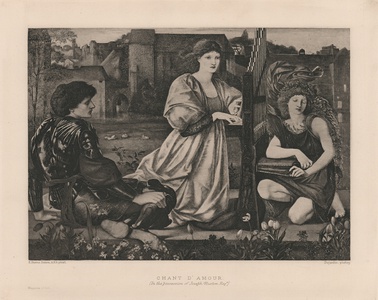| Method | Photogravure |
| Artist | Louis Dujardin after Sir Edward Coley Burne-Jones |
| Published | Magazine of Art, c.1889 |
| Dimensions | Image 161 x 223 mm, Plate 208 x 260 mm |
| Notes |
A scene depicting young woman playing an organ whilst a knight looks on published in The Magazine of Art. The Magazine of Art was an illustrated monthly British journal devoted to the visual arts, published from May 1878 to July 1904 in London and New York by Cassell, Petter, Galpin & Co. It included reviews of exhibitions, articles about artists and all branches of the visual arts, as well as some poetry, and was lavishly illustrated by leading engravers of the period. The subject is thought to have been based upon a refrain from an old Breton song. The lyrics, "Hélas! je sais un chant d'amour / Triste ou gai, tour à tour," translate as: "Alas, I know a love song, / Sad or happy, each in turn." In the print, a portable organ is played by a young woman, whilst the bellows are worked by an angel on the right. To the left, an armoured knight reclines languorously. Arthurian architecture bedecks the backdrop. Tulips and wallflowers adorn the foreground. The former, was a symbol of ardent love; the latter, an emblem of bitterness and conceit. In his use of flowers, the artist can be seen to represent the paradoxical nature of love as alluded to in the poem. This photogravure is one of the many guises that Edward Burne-Jones' work took. The first manifestation appeared in 1862, when Burne-Jones painted a vignette of the scene upon an upright piano that he, and his wife Georgiana, had received as a wedding gift. A preparatory sketch in red chalk appeared in 1863, as did a watercolour in 1865, which was bought by Burne-Jones' patron William Graham. It was Graham who subsequently commissioned the oil painting, though it did not appear in public until the Grosvenor Gallery exhibition of 1878. Louis Dujardin (1808 - 1859) was a French printmaker. Sir Edward Coley Burne-Jones, 1st Bt (1833-1898) was a painter and designer closely associated with the later phase of the Pre-Raphaelite movement. Burne-Jones met William Morris as an undergraduate of Exeter College, Oxford, whilst studying for a degree in theology. The pair went on to work very closely together on numerous decorative arts projects including stained glass windows, tapestries, and illustrations. Originally intending to become a church minister, Burne-Jones never finished his degree, choosing instead to pursue an artistic career under the influence of Dante Gabriel Rossetti. Rossetti heavily inspired his early work, but by the 1860's his idiosyncratic style was beginning to develop. His mature work, however different in total effect, is rich in conscious echoes of Botticelli, Mantegna and other Italian masters of the Quattrocento. Thusly, Burne Jones' later paintings of classical and medieval subjects are some of the most iconic of the Pre-Raphaelite movement. He was at the height of his popularity during the 1880's, though his reputation began to decline with the onset of the Impressionists. He was created a baronet in 1894, when he formally hyphenated his name. |
| Framing | mounted |
| Price | £125.00 |
| Stock ID | 52199 |

